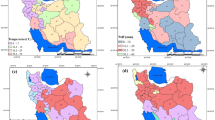Abstract
Access to water and food security in arid and limited water resources regions requires optimal cropping pattern. In this research, virtual water (VW) trade was implemented to find the best cropping pattern in Sistan and Blouchestan province of Iran. Forty-four common cultivated productions in the province were classified in 6 classes including cereals, legumes, vegetables, oil crops, fruits, and potato. Required data were collected during 2000–2011. The improper distribution of crops in the current cropping pattern led to a high mean value of TVW both at the county (0.53–4.35 m3 kg−1) and province levels, where blue VW accounted for 91.3–98.5 % of TVW. By considering three indices including VW, unit blue water value, and the ratio of required blue water to the total water allocation for the agriculture, the optimal cropping pattern was proposed as potato followed by vegetables, legumes, fruits and cereals. Based on the results, production of vegetables and potato both at the county and province levels might be a target for improvements and might contribute significantly for reducing national water use for irrigation.





Similar content being viewed by others
References
Allan JA (1993) Fortunately there are substitutes for water otherwise our hydro-political futures would be impossible. In: ODA, priorities for water resources allocation and management. ODA, London, pp 13–26
Allen RG, Pereira LS, Raes D, Smith M (1998) Crop evapotranspiration guide Lines for computing crop water requirements, Irrigation and Drainage Paper 56, Rome, Italy. p 300
Chapagain AK, Tickner D (2012) Water footprint: help or hindrance? Water Altern 5(3):563–581
Darzi-Naftchali A, Shahnazari A (2014) Influence of subsurface drainage on the productivity of poorly drained paddy fields. Eur J Agron 56:1–8
De-FraitureC, Cai X, Amarasinghe U, Rosegrant M, Molden D (2004) Does international cereal trade save water? The impact of VW trade on global water use. Comprehensive assessment of water management in agriculture. Int Water Manag Inst
Fader M, Gerten D, Thammer M, Heinke J, Lotze-Campen H, Lucht W, Cramer W (2011) Internal and external green-blue agricultural water footprints of nations, and related water and land savings through trade. Hydrol Earth Syst Sci 15(5):1641–1660
FAO (2012) Fao statistical year book. Food and Agriculture Organization of the United Nations, Rome, p 352
FAO (2013) CROPWAT Model. [Online]. Food and Agriculture Organization, Rome. Available: www.fao.org/nr/water/inforesdatabasescropwat.html
Hoekstra AY, Hung PQ (2002) Virtual water trade: a quantification of virtual water flows between nations in relation to international crop trade. UNESCO-IHE, Delft
Hoekstra AY, Chapagain AK (2007) Water footprints of nations: water use by people as a function of their consumption pattern. Water Resour Manag 21:35–48
Karandish F, Shahnazari A (2015) Soil temperature and maize nitrogen uptake improvement under partial root-zone drying. PEDOSPHERE. In press
Mekonnen MM, Hoekstra AY (2012) Water footprint benchmarks for crop production. UNESCO-IHE. Research paper series No.64. 25p
Ridoutt B, Juliano P, Sanguansri P, Sellahewa J (2010) The water footprint of food waste: case study of fresh mango in Australia. J Clean Prod 18(16):1714–1721
Su X, Li J, Singh VP (2014) Optimal allocation of agricultural water resources based on virtual water subdivision in Shiyang River basin. Water Resour Manag 28:2243–2257
Wang X, Zhang Z, Long A, Xu Z (2005) Review of virtual water research. China Rural Water Hydropower 1:27–30
Yang H, Wang L, Abbaspour KC, Zehnder AJB (2006) VW trade: an assessment of water use efficiency in the international food trade. Hydrol Earth Syst Sci 10:443–454
Yu Y, Hubacek K, Feng K, Guan D (2010) Assessing regional and global water footprints for the UK. Ecol Econ 69(5):1140–1147
Zhang C, McBean EA, Huang J (2014) A virtual water assessment methodology for cropping pattern investigation. Water Resour Manag 28:2331–2349
Zhao X, Chen B, Yang Z (2009) National water footprint in an input–output framework—a case study of China 2002. Ecol Mod 220(2):245–253
Author information
Authors and Affiliations
Corresponding author
Rights and permissions
About this article
Cite this article
Karandish, F., Salari, S. & Darzi-Naftchali, A. Application of Virtual Water Trade to Evaluate Cropping Pattern in Arid Regions. Water Resour Manage 29, 4061–4074 (2015). https://doi.org/10.1007/s11269-015-1045-4
Received:
Accepted:
Published:
Issue Date:
DOI: https://doi.org/10.1007/s11269-015-1045-4




